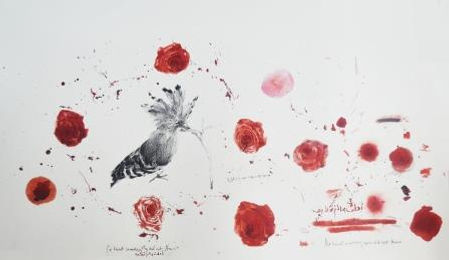HANAA MALALLAH
I Have Learnt Something You Did Not Know
60 x 100 cm
Black and red ink on paper
Survival Hoopoe
40 x 31 cm
Digital Print
5/20
“The Hoopoe bird appears in many ancient religious texts. I have started to follow the concept that is presented by the Hoopoe as a bird seeking truth to survive morally and spiritually, by starting a dangerous journey. I have used the Hoopoe as a symbol of suffering and survival in my artworks for the last six years, often in comparison to the Dove with olive branch. While the Dove was originally a Christian symbol, it was transformed into an iconic, secular symbol of peace by Pablo Picasso. Similarly, I have reworked the Hoopoe and olive branch as a symbol of survival in a secular context. I tried to deliver my concept by using taxidermy Hoopoe birds to explain that the shape is there but the content (life) is not.”
The Hoopoe bird appears in a number of works by Malallah, whether painted, drawn in pen and ink or appearing as taxidermy. The Hoopoe inspires Malallah for a number of reasons, and has both religious and secular associations for the artist. The Hoopoe bird is native to Asia, Africa and parts of Europe, and has been depicted in art and literature since ancient times. Due to its crown-like crest, it has often been described as a leader or king of birds. The Hoopoe bird (hudhud in Arabic) is also important in Islamic tradition, because it appears in a number of religious texts, most notably in the Holy Qur’an. It has been seen throughout history as sacred, wise and protective.
Malallah has also extensively researched the appropriation of the Biblical Dove and olive branch as a secular symbol for peace. The use of Picasso’s Dove of Peace (La Colombe de la Paix, 1949) as a symbol of pacifism worldwide has resulted in associations beyond the religious. In Malallah’s work, she replaces the Dove with the Hoopoe, which reframes the bird and olive branch motif to represent not peace but survival through destruction. There is, however, an inherent irony with the use of taxidermied, dead Hoopoe birds to represent the idea of survival. It is almost as if the empty bodies of expired birds represent the hollow emptiness associated with survivor guilt.
Malallah relates to the Hoopoe bird because of its historic association with moral and spiritual guidance, and legends of dangerous journeys undertaken by the bird, often inviting others to share in the experience. The artist equates these journeys to her own artistic journey, in which she undertakes to seek the truth in order to survive. In her work, the Hoopoe has become a symbol of survival itself.
Louisa Macmillan, October 2014



Hanaa Malallah studied Fine Art in Baghdad with an emphasis on graphics and painting. In 2005 her thesis concerning the logic order in Mesopotamian drawing gained her a PhD in the Philosophy of Painting. She has taught and lectured widely at several faculties of the University of Fine Arts in Baghdad. At the end of 2006 she left Iraq for an artist residency at the Institute du Monde Arabe in Paris and from there followed the call of a fellowship offered by SOAS in London in 2008. She held a fellowship at the Chelsea College of Art in London from 2011 to 2013. She currently she works as associate professor at Royal University for Woman (RUW) in Bahrain and concentrates on research.
Her work graces numerous private collections, art centres and museums, including the Centre for Modern Art, Baghdad, the Jordan National Museum Amman, The British Museum, The Arab Museum of Modern Art, Doha, The Barjeel Art Foundation, Sharjah.
Hanaa Mallalah is internationally acclaimed for her material-focused practice and her philosophical/spiritual explorations into the nature of being and not being.
